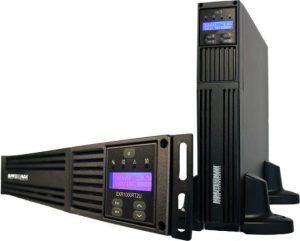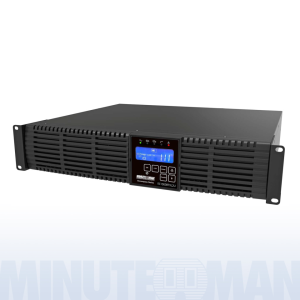THE NEED FOR POWER PROTECTION
Keeping Distributed Antenna Systems (DAS) powered up and fully protected is not only essential, but most local government entities mandate that a DAS system is fully functional for emergency responders’ communications inside a facility – even when power is out. To go a step further, these vital communications systems are often required by local regulations to be fully functional for 12, and even 24 hours.
Minuteman Power Technologies specializes in providing long-battery backup solutions that meet or exceed the local jurisdiction requirements for keeping DAS systems up and running. As the early pioneer in long-run battery backup systems, Minuteman has the experience and expertise that uniquely positions us as the go-to power solution provider for DAS applications.
WHY DAS?
Just like we have become accustomed to having electricity 24/7, the latest utility that we expect to be available at all times is wireless communications. Wireless systems and the infrastructure that supports them have become pervasive, and the expectation is that wireless services must be available at all times for us to communicate with friends and family, as well as conduct business without interruption. The ability to be mobile and still communicate is now an expectation, no matter where we are or what we are doing inside or outside. Wireless communications is now the fourth utility. Cell phone traffic has increased exponentially, and all cell carriers must stay out in front of capacity demand from their users. While voice traffic has increased slightly each year, the demand for cell phone data internet browsing, and streaming video has skyrocketed.
The landscape is covered with cellular towers, but the vast majority of cellular connections (70-80% for both voice and/or data) originate inside buildings. As stated earlier, full wireless coverage inside a building is expected. Radiofrequency signals often cannot easily penetrate walls, elevators, and even windows in large buildings. The solution is low-power cellular antennas placed inside buildings to provide reliable service. There are other reasons in support of cellular systems inside buildings or structures. Sometimes the number of users inside a building like a convention center or sports facility exceeds the bandwidth of a single cellular tower. Thus, the solution is a “distributed” approach to providing full coverage that can handle a large amount of communications traffic. Distributed Antenna Systems (DAS) were developed to fulfill the requirement of providing reliable RF penetration and coverage throughout a facility.
CODES AND REGULATIONS
The National Fire Protection Association (NFPA) and the International Fire Code (IFC) have established working standards that outline minimum requirements, but local jurisdictions set their local code which can deviate from the IFC or NFPA standards. Part of the code for building wireless coverage includes:
-
- The building shall have 99% floor area radio coverage in critical areas, such as the fire command center(s), the fire pump room(s), exit stairs, exit passageways, elevator lobbies, standpipe cabinets, sprinkler sectional valve locations, and other areas deemed critical by the authority having jurisdiction.
- A minimum inbound signal strength of -95dBm, or other signal strength as required by the authority having jurisdiction, shall be provided throughout the coverage area.
- A minimum outbound signal strength of -95 dBm at the donor site, or other signal strength as required by the authority having jurisdiction, shall be provided from the coverage area.
- Buildings and structures that cannot support the required level of coverage shall be equipped with a radiating cable system or distributed antenna system (DAS) with FCC-certified signal booster, or both, or with a system that is otherwise approved, in order to achieve the required adequate coverage.
- Two sources of power are required:
-
-
- The primary source must be a dedicated AC line that complies with the NFPA Code 72.
- The secondary source must consist of a storage battery system capable of supporting 100% of operating capacity for 12 hours. The alternative source of secondary power (either a generator or battery backup) must also provide 12 hours of backup power at 100% capacity. Either alternative must be approved by the Authority Having Jurisdiction( AHJ).
To enforce these standards, state or local jurisdictions must adopt them. Local adoption typically involves stringent enforcement, with the potential for withholding a certificate of occupancy if minimum signal coverage and backup power requirements are not met. Many jurisdictions conduct facility-wide testing to ensure that Distributed Antenna Systems (DAS) meet or exceed local codes. Local regulations consider building size and population density when determining mandatory DAS installation. These codes underscore the critical need for backup power. During power outages or emergencies, inadequate backup power could severely limit communication among first responders or facility occupants, posing significant risks. Verify local codes for specific battery backup requirements and runtime to comply with regulations.
POWER REQUIREMENTS OF DAS SYSTEMS
Since DAS installations require longer battery backup times than usual, Minuteman is uniquely positioned to offer solutions that meet the stringent requirements.
Minuteman was the early pioneer in adding an external battery pack to a UPS in the market below 3000VA. More than 27 years ago, Minuteman’s first models with extended runtime capability debuted. Since then, our extended runtime products have established a reputation for ease of installation, exceptional value, and unmatched reliability.
Two sizes of battery packs are available, providing an unmatched level of customization and ensuring the perfect configuration can be achieved, no matter the demands. Minuteman’s CRTXL, RTXL, and RTEXL battery packs for Encompass RTXL and EXR Series UPSs provide a virtually unlimited runtime potential thanks to their daisy-chain capability. This allows users and resellers to easily configure an affordable UPS solution for even the most challenging runtime requirements.







